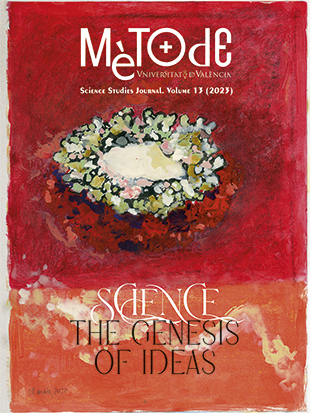Intensification of livestock farming in times of climate change: The challenges of domestic grazing in the drylands of the Argentine Patagonia
DOI:
https://doi.org/10.7203/metode.13.21553Keywords:
Patagonian steppe, functional diversity, biological soil crusts, sheep production, desertification Abstract
Abstract
Livestock grazing modifies and even degrades arid ecosystems, which threatens the sustainability of livestock farming itself. It is essential to learn more about the effects of grazing on vegetation and soil to design strategies to avoid desertification, perhaps the most serious problem faced by drylands. In this paper, we evaluate the changes in the functional traits of the plant community and the biological soil crust induced by the intensification of grazing in Patagonian ecosystems. This description, together with changes in diversity, plant composition, and ecosystem functioning, can help us to understand the mechanisms by which the intensification of sheep grazing could degrade arid ecosystems.
 Downloads
Downloads
 References
References
Austin, A. T., & Sala, O. E. (2002). Carbon and nitrogen dynamics across a natural precipitation gradient in Patagonia, Argentina. Journal of Vegetation Science, 13(3), 351–360. https://doi.org/10.1111/j.1654-1103.2002.tb02059.x
Carboni, L. (2019). La intensificación del pastoreo produce efectos diferenciales en la cobertura y composición vegetal en un gradiente regional de aridez. [Undergraduate dissertation in Environmental Sciences, Faculty of Agronomy, University of Buenos Aires]. Argentina.
Censo Nacional Agropecuario. (2018). Resultados preliminares, ganadería. Instituto Nacional de Estadística y Censos – INDEC.
Cesa, A., & Paruelo, J. M. (2011). Changes in vegetation structure induced by domestic grazing in Patagonia (Southern Argentina). Journal of Arid Environments, 75(11), 1129–1135. https://doi.org/10.1016/j.jaridenv.2011.04.003
Flombaum, P., Yahdjian, L., & Sala, O. E. (2017). Global-change drivers on ecosystem functioning modulated by natural variability and saturating responses. Global Change Biology, 23(2), 503–511. https://doi.org/10.1111/gcb.13441
Gaitán, J. J., Bran, D. E., Oliva, G. E., Aguiar, M. R., Buono, G. G., Ferrante, D., Nakamatsu, V., Ciari, G., Salomone, J. M., Massara, V., García Martínez, F., & Maestre, F. T. (2018). Aridity and overgrazing have convergent effects on ecosystem structure and functioning in Patagonian rangelands. Land Degradation & Development, 29(2), 210–218. https://doi.org/10.1002/ldr.2694
Huang, J., Yu, H., Guan, X., Wang, G., & Guo, R. (2016). Accelerated dryland expansion under climate change. Nature Climate Change, 6, 166–171. https://doi.org/10.1038/nclimate2837
Le Houérou, H. N. (1996). Climate change, drought and desertification. Journal of Arid Environments, 34(2), 133–185. https://doi.org/10.1006
/jare.1996.0099
León, R. J. C., Bran, D., Collantes, M., Paruelo, J. M., & Soriano, A. (1998). Grandes unidades de vegetación de la Patagonia extra andina. Ecología Austral, 8(2), 125–144.
Maestre, F. T., Quero, J. L., Gotelli, N. J., Escudero, A., Ochoa, V., Delgado-Baquerizo, M., García-Gómez, M., Bowker, M. A., Soliveres, S., Escolar, C., García-Palacios, P., Berdugo, M., Valencia, E., Gozalo, B., Gallardo, A., Aguilera, L., Arredondo, T., Blones, J., Boeken, B., … Zaady, E. (2012). Plant species richness and ecosystem multifunctionality in global drylands. Science, 335(6065), 214–218. https://doi.org/10.1126/science.1215442
Oñatibia, G. R. (2021). Grazing management and provision of ecosystem services in Patagonian arid rangelands. In P. L. Peri, G. Martínez Pastur, & L. Nahuelhual (Eds.), Ecosystem services in Patagonia (pp. 47–74). Springer. https://doi.org/10.1007/978-3-030-69166-0_3
Oñatibia, G. R., Amengual, G., Boyero, L., & Aguiar, M. R. (2020). Aridity exacerbates grazing‐induced rangeland degradation: A population approach for dominant grasses. Journal of Applied Ecology, 57(10), 1999–2009. https://doi.org/10.1111/1365-2664.13704
Oyarzabal, M., Clavijo, J., Oakley, L., Biganzoli, F., Tognetti, P., Barberis, I., Maturo, H. M., Aragón, R., Campanello, P. I., Prado, D., Oesterheld, M., & León, R. J. C. (2018). Unidades de vegetación de la Argentina. Ecología Austral, 28(1), 40–63. https://doi.org/10.25260/EA.18.28.1.0.399
Velasco Ayuso, S., Oñatibia, G. R., Maestre, F. T., & Yahdjian, L. (2020). Grazing pressure interacts with aridity to determine the development and diversity of biological soil crusts in Patagonian rangelands. Land Degradation and Development, 31(4), 488–499. https://doi.org/10.1002/ldr.3465
Yahdjian, L., & Sala, O. E. (2008). Climate change impacts on South American Rangelands. Rangelands, 30(3), 34–39. https://doi.org/10.2111/1551-501X(2008)30[34:CCIOSA]2.0.CO;2
Yahdjian, L., Sala, O. E., & Havstad, K. M. (2015). Rangeland ecosystem services: Shifting focus from supply to reconciling supply and demand. Frontiers in Ecology and the Environment, 13(1), 44–51. https://doi.org/10.1890/140156
Downloads
Published
How to Cite
-
Abstract1740
-
PDF656
Issue
Section
License
Copyright (c) 2023 CC BY SA

This work is licensed under a Creative Commons Attribution-ShareAlike 4.0 International License.
![]()
All the documents in the OJS platform are open access and property of their respective authors.
Authors publishing in the journal agree to the following terms:
- Authors keep the rights and guarantee Metode Science Studies Journal the right to be the first publication of the document, licensed under a Creative Commons Attribution-NonCommercial-NoDerivatives 4.0 International License that allows others to share the work with an acknowledgement of authorship and publication in the journal.
- Authors are allowed and encouraged to spread their work through electronic means using personal or institutional websites (institutional open archives, personal websites or professional and academic networks profiles) once the text has been published.





